Sargassum-Algae with Mysterious Power【1】
The genus Sargassum belongs to the family of Brown Algae, Order Murrayana and Family Sargassaceae, and was established by Swedish algal scientist C. Agardh. At present, there are more than 260 species in the world, widely distributed in tropical and temperate regions, and more than 100 species have been recorded in China. It grows in the rocky marshes in the low-tide zone or the rocks in the subtidal zone at a depth of 2 meters to 3 meters, or in the rocky marshes in the middle and low-tide zones. Widely distributed in warm water and warm water sea, especially in India - West Pacific and Australia. China is one of the main production areas of Sargassum, there are sixty species. It is prevalent along the coasts of Guangdong and Guangxi, especially Hainan Island and Chau Island and Weizhou Island.
Sargassum species, some species due to regional, environmental or age differences, often produce external morphological variation, and even the same algae body of the upper and lower parts of the morphology can be a lot different. Therefore, the different parts of some Sargassum algae can be easily named as several to more than ten species, which makes the phenomenon of different names for the same species and different species with the same name more common in the classification of Sargassum. Today, we introduce seven species of Sargassoaceae in detail.
Six of them are Sargassum (Sargassum C. Agardh) and one is Hizikia (Hizikia0kamura).
Sargassum is characterized by a large algal body, which can be clearly divided into four parts: the "root", the "stem", the leaves and the air sac. The "root" is the anchoring apparatus, which can be disk-shaped, cone-shaped, split-valve-shaped, and pseudoradical, etc. The "stem" is the root of the alga, which is the root of the alga. The "stem" is divided into the main stem, main branches, lateral branches and twigs. The main stem is short, generally only a few centimeters or less; the main branches are long and terminal, cylindrical, compressed or triangular; lateral branches and twigs are alternate on both sides of the main branches and lateral branches or around them. Leaves flattened, entire or toothed. Aerial sacs spherical or terete, growing from the leaf axils, rounded at the apex or with a small protuberance or corolla. The Sargassum zoosome is a biphasic sporophyte that undergoes meiosis at maturity to produce spermatozoa and eggs directly, with no separate gametophyte stage. The spermatophore and egg sacs grow in the reproductive fossa of the germinal receptacle. The germinal receptacle is cylindrical, cylindrical-forked, or flattened and leaf-shaped. There are different types of zoospores such as dioecious, dioecious heterothallic, dioecious heterothallic and dioecious homothallic.
Today we introduce the following seven species, copper algae, Sargassum, Watson's sargassum, sea kibble, split-leaf sargassum, half-leaf sargassum Chinese varieties, goat weed.
1. Sargassum horneri
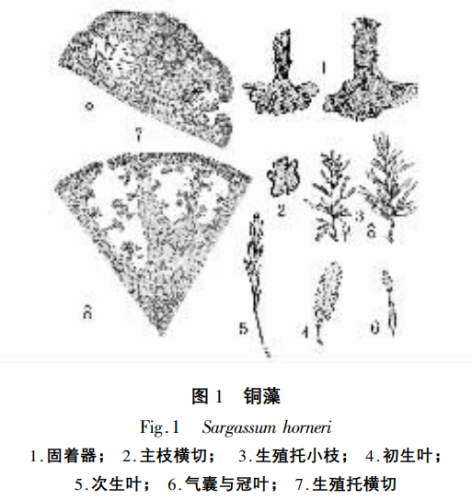
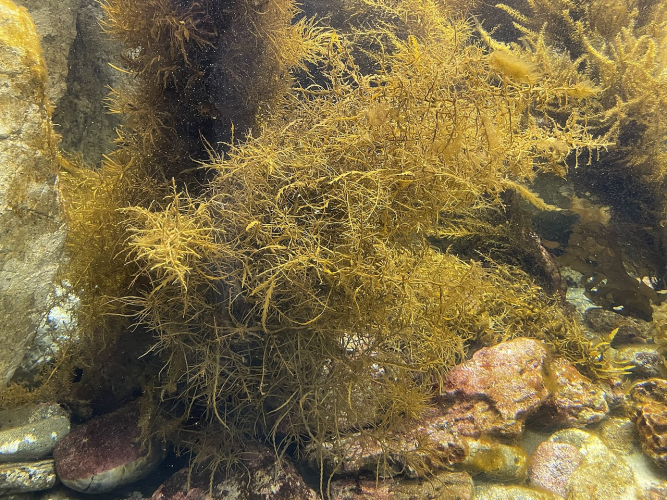
The body is yellowish brown, 300-700 mm high, up to 3.5 m. The fixation apparatus is cleft petaloid. The main stem is short, 10-15 mm. the main branch is terete, with 3-5 shallow grooves going longitudinally, alternating with lateral branches in all directions, and the leaves at the base of the main branch are slightly reflexed. Primary leaves are fusiform, appearing only when young, with finely denticulate margins. Secondary leaves are 40-50mm long, with margins parted to form canine serrations, leaf midribs evident and disappearing near the tip below. Aerocarps cylindrical, 10mm long, aerocarp stalk 2-3mm long, aerocarp apical crown leaves pinnate and midribbed (Fig. 1). Algae dioecious. The receptacle is single and terete, the proximal portion of the receptacle acute into a short stalk, arising from the leaf axils of lateral branches or twigs. Female receptacle short, head obtuse, length about 15-20mm, stipe about 2mm long; male receptacle 20mm long, up to 60mm, stipe 1-1.5mm long, tip. In cross-section, the epidermal cells are subangular, attached to the tip of the lateral filaments; the oocysts are elliptical or pear-shaped.
2. Sargassum thunbergii
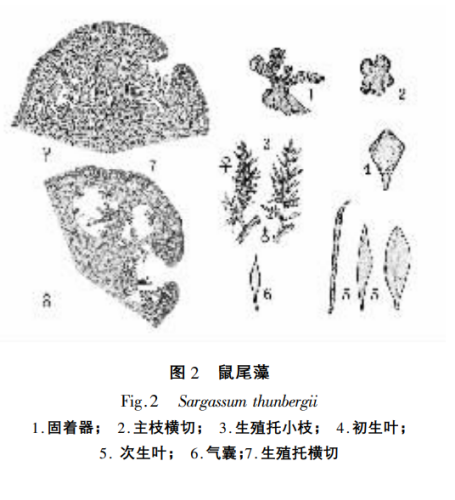
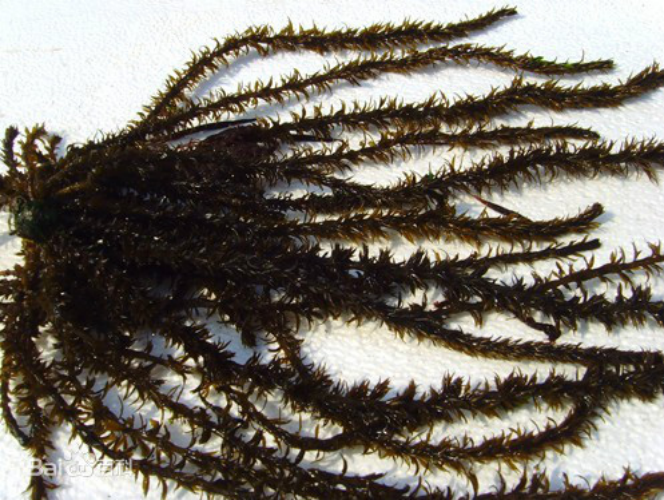
Body brown, 400-600mm high, up to 1.4m or more. Fixed apparatus discoid, perennial for cleft petal-like, main stem short, about 10mm long. main branch 4-6 terete, each main branch has 4-5 longitudinal shallow grooves. Leaves short, crowded on main branches, primary leaves scale-like, secondary leaves fine-needle, lanceolate or fusiform. The air sacs are fusiform, pointed, and formed by the middle part of the acicular leaves being expanded and the pith being hollow. Individuals of mature S. rhamnosus are often laterally branched (Fig. 2). Algae dioecious. Reproductive stipes are single and cylindrical, female stipes 4-5 mm long, stipes about 1 mm long; male stipes 6-8 mm long, slightly thinner than female stipes. Reproductive tray cross-section view of the epidermal cells rectangular, spermatophore long capsule, inserted in the base of the lateral filaments on both sides of the three cut side, oocysts oval or pear-shaped.
3. Sargassum vachellianum
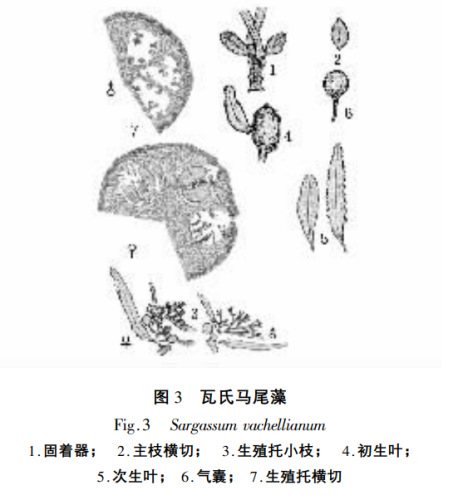
The body is brownish-green, 600-900mm high, and the adhesive apparatus is disk-shaped. The main stem is cylindrical, 10-15mm long, 3-5mm in diameter, with 2-3 main branches, flattened and unarmed. Lateral branches flattened, alternate, in plane with main branches. Primary leaves compressed globose, 2-3, borne at the upper end of the main stem, 12mm long, 7mm wide, 2-3mm thick, sometimes with leaflets at the top or on both sides of the primary leaves. Basal secondary leaves lanceolate, edges without teeth; upper secondary leaves long lanceolate, apex obtuse, leaf margins serrulate, midrib conspicuous, and apex. Air sacs globose, 3-6 mm in diameter, with a slender stalk (Fig. 3). Algae dioecious. Gonopods terete, 2-4-forked branches, male branches 2-5mm long, up to 10mm at the end, female branches short and dense, 1mm. epidermal cells rectangular in cross-section of gonopods. The spermatophore is large and grows on either side of the base of the lateral filaments, and the oocyst is oval.
We will continue to introduce more content to you in the next article....



 Mobile: 86-13012553585 15610518510
Mobile: 86-13012553585 15610518510 Phone (Fax):86-53283197178
Phone (Fax):86-53283197178 E-mail: admin@bluealga.com
E-mail: admin@bluealga.com Add:No.918 Lingang 8 Road Huangdao District,Qingdao China 266400
Add:No.918 Lingang 8 Road Huangdao District,Qingdao China 266400

